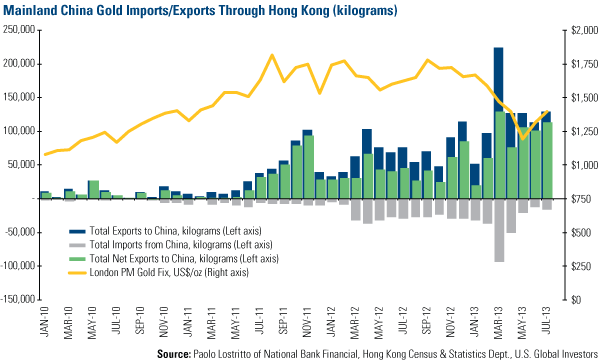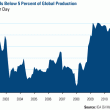Gold Market Radar (September 16, 2013)
For the week, spot gold closed at $1,326.39, down $65.51 per ounce, or 4.71 percent. Gold stocks, as measured by the NYSE Arca Gold Miners Index, lost 8.42 percent. The U.S. Trade-Weighted Dollar Index lost 0.79 percent for the week.
Strengths
- Paolo Lostritto, Director at National Bank, shared his most recent physical gold research with our team. According to Paolo, notwithstanding all the taper talk, physical gold continues to migrate east. Year-to-date net physical imports by China equate to approximately 37 percent of global mine supply. This in addition to the reports from GFMS suggesting that China is the world’s largest gold producer, with an estimated 400-plus tonnes annually, or roughly 14 percent of global mine supply. This suggests that China on its own, is amassing nearly half of the world’s annual gold supply within its borders.
- Gran Colombia Gold just provided an update of its production numbers showing August production was 9,988 ounces of gold; bringing year-to-date total production to 70,939 ounces, on track to achieve 2013 guidance of 110,000 ounces of gold. All-in sustaining costs remain on target to less than $1,150 as cost reduction efforts continued in August with additional workforce reductions. Pan American Silver Corp has decided to close out its outstanding silver and gold hedges by entering into forward contracts for 5.3 million ounces of silver and 24,000 ounces of gold, at average prices of $20.43 per ounce of silver and $1,323 per ounce of gold. The transaction highlights renewed confidence by producers in higher precious metals prices.
- Mandalay Resources tabled a Preliminary Economic Assessment (PEA) for the development of the Cuffley Lode at its Costerfield mine. The PEA assumed a minable resource of 509,000 tonnes of gold grading 10.5 grams per tonne. The study assumed gold prices of $1,300 per ounce and resulted in an IRR greater than 3,300 percent. Osisko Mining confirmed the throughput at its Canadian Malarctic mine has reached levels above 1 gram per tonne, reassuring investors following a 0.88 gram per tonne average during the first half of the year. Sulliden Gold announced that Peru's Ministry of Energy and Mines has approved the Environmental Impact Assessment (EIA) for the Shahuindo gold and silver project in northern Peru. The approval of the EIA is the key milestone in the advancement of the project towards the construction phase.
Weaknesses
- The bullion plunge this week sent the yellow metal breaking below the 100- and 50-day moving average. The decline is certainly an indicator that the focus is now on the upcoming FOMC meeting and away from the recent Syrian tensions. However, Lawrence Williams of Mineweb has reported strange dealing patterns are adversely affecting the gold price. These dealings revolve around the “flashing” of massive gold contracts for sale to traders, at a time of day that there is normally little or no activity in the markets, and no news story being released. This has happened for both of the past two days, between the Asian market close and the European bourses opening. Some even reckon China may be behind the manipulations; perhaps as yet another way of moving physical gold from West to East as part of an ongoing pattern to corner the global supply of gold.
- Macquarie issued a report to give gold investors an indication of how much exploration activity has declined this year. Major Drilling, a sizeable market player, has reported that usage of its rigs is currently sitting at 33 percent, a far cry from the 75 percent utilization rate twelve months ago. The company has taken up to 20 percent cut on pricing for jobs, and admits that it is only a breakeven business in this market. The order book is wide open in case anyone wants to book a drill, leading to the conclusion that reserve replacement will be negative this year.
- Sales of Perth Mint gold coins and minted products for August 2013 totaled 30,430 ounces. This amount represented a decline both from the prior month when 56,488 ounces were sold. This has given room for gold bears to say the increase in physical buying is unsustainable. However, year to date, gold sales have reached an unprecedented 492,543 ounces.
Opportunities
- HSBC commodities research is of the opinion investment demand is no longer determining gold prices; instead they believe the price is now being driven by physical demand for jewelry, coins, and bars from China. Indeed, greater losses were staved off by a massive increase in physical demand emanating mostly from China where we estimate imports may be as much as 1,000 tonnes this year. China imported 647 tonnes of gold in the first seven months of 2013, according to available data. To put the scope of buying in context, the largest gold ETF holds 919 tonnes of physical gold, and China has imported over two thirds that amount in just seven months.
- HSBC update its gold supply and demand forecasts for 2013 and 2014, saying tepid mine growth supply, lower scrap supplies, and steady central bank demand will support gold prices. In terms of supply, mine production delays, cost pressures, and lower scrap supply will be price-supportive for gold.
- The most recent elections in Australia have elected a new pro-mining government. While expected, the confirmation of Tony Abbott’s Liberal-National coalition is certainly big news this week. According to our contacts in the country, the incoming government is very much viewed as pro-business, and pro-resources. Evidence of which is their election platform, which included not only the promise to abolish the 30 percent tax on mining sector profits, but also the dismantling of the carbon pricing mechanism.
Threats
- President Obama will name former Treasury Secretary Larry Summers as Fed Chairman as early as next week, according to a Japanese newspaper. The White House denied the report without a visible market response. The market views Summers as hawkish as analysts say he may provide less stimulus than Bernanke.
- According to Goldman Sachs’s head of commodities research Jeffrey Currie, the bank’s new target for gold price in 2014 is $1,050, adding the commodity may overshoot to the downside. UBS went on to say a $1,000 level is “on the cards.” Credit Suisse joined to bandwagon by adding there is a possibility of gold trading below $1,000 as bullion faces downward pressure as inflation risks remained muted. Societe Generale, Citigroup, ABN Amro and Macquarie are among banks predicting lower prices in 2014, while JPMorgan and Bank of America said bullion may be bottoming as the rout boosts demand.
- In April, Mexico's lower house of Congress approved a new royalty framework to redistribute mining profits to the states and municipalities. However, before the bill could make its way through Senate, it was added to President Pena Nieto’s comprehensive fiscal reform, which is now proposing a royalty of 7.5 percent of earnings before interest, taxes, depreciation and amortization (EBITDA). Miners were already disconcerted by the original 5 percent royalty proposal, and this new take is granted to disgruntle mining investors to a greater extent.

















